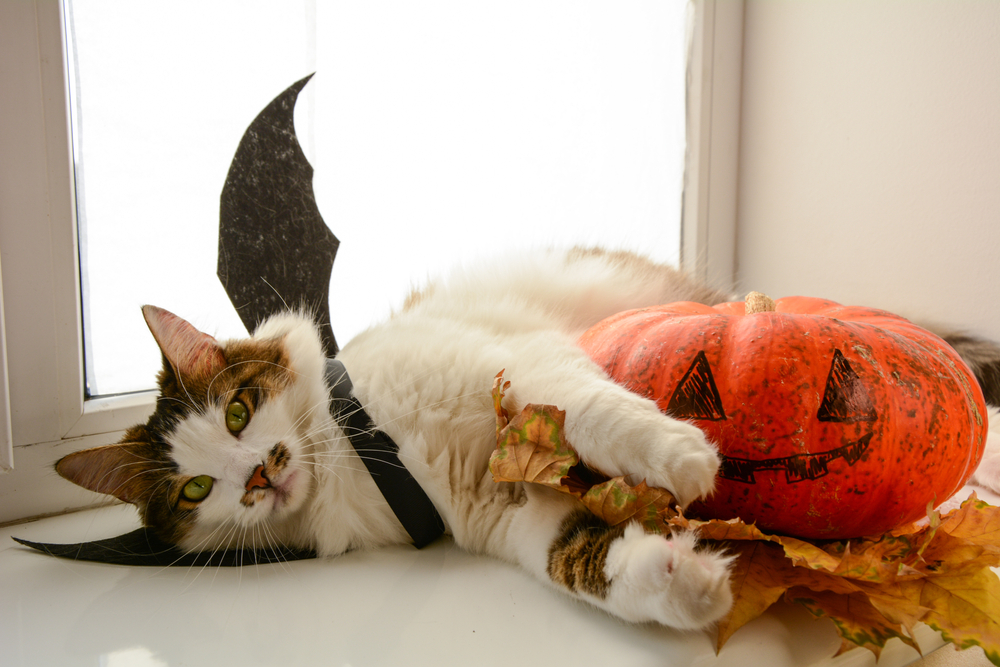Watch out! Halloween is rich with potential pet-safety hazards—which are no joke. Cruel reality lurks inside many popular holiday festivities, waiting to pounce on unsuspecting pet owners. Don’t be fooled by the holiday’s sweetness. Check out Acorn Animal Hospital’s guide to Halloween pet safety, and learn how to turn potential frights to harmless delights.
Fright = The runaway pet
Your dog loves meeting new people and participating in family activities, so you don’t think twice about letting them greet trick-or-treaters. However, when a giant T-Rex appears on your doorstep, your dog startles, and darts outside. The next thing you hear is screeching tires, and you spend all night searching for your missing dog.
Delight = Preventing pet panic by creating a safe, quiet space
Any pet can be frightened by strange costumes, sounds, and decorations, and they can escape through an open door in a split second. For their safety, take the following precautions:
- Identification — Ensure your pet is wearing a well-fitted collar and tags with current contact information.
- Extra identification — Have your pet permanently identified with a microchip, and register the chip in your name and phone number.
- Personal space — Confine your pet to a quiet room, pen, or crate on Halloween night. Include a comfortable bed, toys, litter box, and water. Play music to drown out the spooky sounds outside.
- Home away from home — Consider boarding your pet for the night, if they get spooked by a hectic house.
While it’s nice to include your pet in the holiday fun, a peaceful getaway is always better than a panicked escape.
Fright = The candy-stealing pet
Your dog noticed the candy bowl on the foyer table this morning, and waited until you left to help the kids with their costumes. When you returned downstairs, you noticed your dog’s absence, and found them surrounded by shredded candy wrappers, chewing on a mini candy bar. An assortment of chocolate, gummy candies, and jawbreakers are missing from the bowl. You call Acorn Animal Hospital, and your dog is admitted for emergency treatment.
Delight = Preventing pets eating toxic treats
Who can resist candy and other sweet treats? Certainly not our pets. Unfortunately, certain ingredients, including chocolate, xylitol, raisins, grapes, and macadamia nuts, are dangerous for pets, and require veterinary attention, if ingested.
Store candy in closed containers on inaccessible shelves to prevent curious paws from digging in. Do not allow children to take candy to their rooms—unattended bags and buckets make easy pickings for pets. Make or purchase pet-safe Halloween treats that you feed your pet for their evening meal, before the candy comes out.
Fright = The fear-aggressive pet
You’ve dressed your dog in a superhero cape, and taken them trick-or-treating. Everything is going well, until your neighbor approaches dressed as a monster. Your dog freezes in place, but wags his tail stiffly. He watches with narrowed eyes—trying to recognize the neighbor, you assume. But when your monster-neighbor reaches down to adjust your dog’s cape, your dog bites his hand.
Delight = Reading and respecting your pet’s body language
Pets send clear signals through their body movements and facial expressions, but you must know the language, to prevent bad situations. Dogs and cats vary slightly, but display fear and anxiety in similar ways:
- Cowering posture, or tall and tense if aggressive
- Hard, staring eyes
- Ears pinned back, or fully forward
- Stiffly wagging or twitching tail, or tucked tail
- Dilated pupils
- Hypervigilance
- Raised hair over the shoulders
- Stillness, or moving in slow motion
Fear and anxiety precede defensive aggression, such as scratching or biting, when your pet is scared, and trying to communicate their feelings. Although many pets will give a warning growl or hiss before biting or striking, other pets use only body language to express their intentions. When body language is not respected (e.g., the neighbor continues to approach), the pet feels they have no option, except to defend themselves against the perceived threat.
Acorn Animal Hospital strongly recommends pets be left at home during trick-or-treating.
Fright = The pet with a wardrobe malfunction
The cat on the package looked adorable in their sailor costume, but the costume is a little snug on your Siamese. Your cat leaves the room before you finish their fitting, and in their attempt to escape, they snake one arm inside the shirt, and hook their claw in the starched white fabric. Suddenly off-balance, they stumble down several stairs.
Delight = A pet-appropriate costume, or none at all

Pets in costume are cute, unless that costume causes stress or a potential safety threat. If you really want your pet in costume, ensure the outfit fits properly—too-loose costumes can trip pets, while those that are too tight can restrict normal movement and breathing. Also, ensure the costume has no dangling accessories, buttons, or small pieces that may get caught or be swallowed.
If your pet shows fearful or anxious body language, they are most likely stressed by their costume. Instead, dress them in only a spooky bandana, or eye-catching collar—or let their costume be their beautiful birthday suit.
Halloween is all about walking the fine line between fear and fun. For our pets’ well-being and safety, take extra precautions and pay mindful attention, to ensure they make it through All Hallow’s Eve with their emotional and physical wellbeing intact.
For additional information about keeping your pet safe this Halloween, contact Acorn Animal Hospital.
